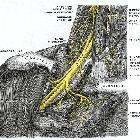Plexus brachialis









The brachial plexus is a complex neural network formed by lower cervical and upper thoracic ventral nerve roots which supplies motor and sensory innervation to the upper limb and pectoral girdle. It is located in the neck extending into the axilla posterior to the clavicle.
Summary
- origin: ventral rami of C5 to T1
- course: emerges between anterior and middle scalenes, courses through the posterior triangle of neck posterior to the clavicle before becoming closely associated with the axillary artery in the axilla before giving up its terminal branches or alternatively the roots emerge from behind the anterior scalenes to form 3 trunks which pass between anterior and middle scalenes, then each trunk divides into an anterior and posterior division which pass behind the clavicle, the divisions combine to form 3 cords which surround the second part of the axillary artery, and finally the cords terminate as the 5 major nerves
- major (terminal) branches
- motor supply: upper limb and pectoral girdle
- sensory supply: upper limb and part of the upper thorax
Gross anatomy
The brachial plexus consists of roots, trunks, divisions, cords and terminal branches as it travels from proximal to distal upper limb. This mnemonic describes the order of these subdivisions.
Roots
Roots are formed between the scalenus anterior and scalenus medius muscles by the anterior rami of C5-C8 and T1 nerve roots. Three branches arise from the roots directly :
- dorsal scapular nerve: arises from the posterior aspect of the C5 root and supplies the rhomboids
- subclavian nerve: arises from the C5 and C6 roots anteriorly to supply subclavius (although some texts describe this nerve arising from the superior trunk )
- long thoracic nerve: arises from the posterior aspects of C5-C7 and supplies serratus anterior
In addition, the scaleni and longus colli muscles are supplied by multiple variable unnamed muscular branches that arise from all or some of the roots .
It is important to remember that although not part of the brachial plexus:
- the dorsal rami course posteriorly into the spinal extensors (erector spinae) and do not contribute to the brachial plexus.
- the ventral rami of C4 and C5 also contribute to the phrenic nerve
- the ventral ramus of T1 also contributes to the first intercostal nerve
Trunks
Trunks form from the roots as they pass between scalenus anterior and medius muscles, then go on to traverse the posterior triangle:
- C5 and C6 roots combine to form the upper or superior trunk
- C7 root makes up the middle trunk
- C8 and T1 roots combine to form the lower or inferior trunk
One branch arises from the trunks :
- suprascapular nerve: arises from the upper trunk and supplies the supraspinatus and infraspinatus muscles, and sensation to the glenohumeral and acromioclavicular joints
Divisions
Each trunk divides to form an anterior and posterior division posterior to the mid clavicle .In general anterior divisions supply muscles of the anterior compartments (flexors) whereas the posterior divisions supply muscles of the posterior compartments (extensors) . No branches arise from the divisions.
Cords
The divisions then combine to form cords, which are named for their relation to the second part of the axillary artery :
- lateral cord is formed by the union of the upper two anterior divisions at the lateral border of the first rib
- medial cord is a continuation of the lower anterior division
- posterior cord consists of the united three posterior divisions
The prevertebral fascia of the neck extends down to ensheath the axillary artery and cords. It is in this axillary sheath that local anesthetic is injected when performing a brachial plexus block .
Peripheral nerves (branches)
Various peripheral nerves, also termed "branches", then branch from these cords.
Branches from the lateral cord are :
- lateral pectoral nerve: C5, 6, 7
- terminal branches
- musculocutaneous nerve: C5, 6, 7
- lateral root of the median nerve: C5, 6, 7, (C8, T1)
Branches from the posterior cord are :
- upper subscapular nerve: C5, 6
- thoracodorsal nerve: C6, 7, 8
- lower subscapular nerve: C5, 6
- terminal branches
- radial nerve: C5, 6, 7, 8, T1
- axillary nerve: C5, 6
Branches from the medial cord are :
- medial pectoral nerve: C8, T1
- medial cutaneous nerve of the arm: C8, T1
- medial cutaneous nerve of the forearm: C8, T1
- terminal branches
- medial root of the median nerve: (C5, 6, 7), C8, T1
- ulnar nerve: (C7), C8, T1
Some authors describe the medial and lateral pectoral nerves arising from shared branches from the medial and lateral cords (as indicated in the diagrams).
The ulnar nerve often receives fibers from the ventral ramus of C7, usually from the median nerve .
Variant anatomy
Approximately 50% of the population shows significant variation in the formation of the brachial plexus:
- pre-fixed brachial plexus: contribution from C4 ventral ramus, with overall contribution from C4-C8 (i.e. the roots are moved up one vertebral level)
- post-fixed brachial plexus: contribution from T2 ventral ramus, with overall contribution from C6-T2 (i.e. the roots are moved down one vertebral level)
- the inferior trunk is at risk of compression by the first rib
- contributions of C4 or T2 ventral rami (6 or 7 roots)
- trunk, divisions or cord may be absent
- variations in branching patterns of the cords have also been reported
Radiographic features
Ultrasound
The roots in the interscalene groove are targeted in an interscalene brachial plexus block, and may be identified by the traffic light sign.
Related pathology
Siehe auch:
und weiter:

 Assoziationen und Differentialdiagnosen zu Plexus brachialis:
Assoziationen und Differentialdiagnosen zu Plexus brachialis:

